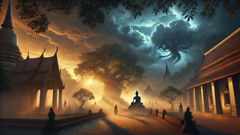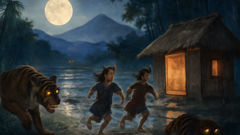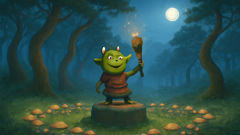Introduction
In the wild heart of Victoria, where the rivers ribbon through the lush ranges and the towering eucalypts cast long, shifting shadows over the undulating earth, stories have always lived alongside the people. Gippsland, in the late 19th century, was a land of raw beauty and mystery—a place where the bush seemed alive with secrets, and every thunderstorm whispered rumors that traveled from one isolated settlement to another. The people here were a hardy, close-knit folk: timber cutters, cattle drovers, gold seekers, and families who built their lives on land carved from wilderness. By day, the forests rang with axe blows and the shouts of children; by night, the wind would rise, carrying strange calls and the distant crash of unseen things. But nothing—not even the most far-fetched tale spun around a crackling pub fire—prepared the people of Gippsland for what happened in the autumn of 1873.
It began, as most legends do, with a single inexplicable sighting. Old Tom McGregor, a shepherd known for his keen eyes and stubborn honesty, was returning from his rounds at dusk when he saw a great shape pass overhead—silent, impossible, glinting faintly against the bruised sky. It was neither bird nor balloon, too swift and sure for any airship known to man. Within days, more witnesses stepped forward, describing a craft that soared above the treetops and vanished without a trace, leaving behind only a ripple of unease and breathless curiosity. Whispers spread across the district: some said it was a ghost ship, others swore it was a trick of the light, but the sightings multiplied, drawing even the most skeptical from their homes to scan the darkening skies.
Gippsland became a place divided between those who feared the unknown and those who hungered for answers. The local constable, the town’s newspaper editor, wandering bushrangers, and even the Kurnai elders each offered their theories, weaving the appearance of the mysterious aircraft—the Gippsland Phantom—into the tapestry of local folklore. As the weeks passed and the legend grew, it ignited hope, suspicion, and awe in equal measure, drawing outsiders and opportunists, skeptics and true believers, into a drama that would ripple through generations. Some believed the Phantom held a warning; others, a promise. All agreed on one thing: Gippsland would never be the same.
The First Sightings: Unease Under the Southern Cross
In 1873, Gippsland was still a land on the edge of the known world. Settlers had carved meandering tracks through the thick forests, and the nearest telegraph post lay days away by horseback. The wild, restless land harbored secrets, but even so, the arrival of something utterly foreign in the skies was almost too much for the locals to comprehend.

It was the evening of April 17th when Old Tom McGregor trudged home, boots heavy with mud, eyes gritty from a day spent trailing his flock along the ridges near Mount Erica. The sky had turned a bruised indigo, and Tom paused to draw in the scent of rain-soaked earth and distant smoke. As he crested a rise, a shadow detached itself from the horizon—a vast, silent shape moving in defiance of wind or bird-flight. For a heartbeat, Tom stood rooted, his breath caught. The craft glided low, perhaps no higher than the tallest gum tree, with wings that shimmered metallic and long tendrils trailing behind. It emitted no sound but seemed to hum with a presence that raised the hairs along Tom’s arms. In a blink, it vanished into the clouds.
Shaken, Tom hurried home and told his wife, Martha. She listened, brow furrowed, but Tom’s reputation for honesty carried weight. Within days, other farmers claimed to have seen something similar—a silvery glint in the dawn, a shadow flickering across the moon, even a strange set of tracks pressed into muddy paddocks. Reports flooded into the Maffra Gazette: schoolteacher Alice Conroy described a “great bird, all made of glass and steel,” while a timberman named Henry Fellows insisted he’d seen lanterns flickering along its sides. Not everyone believed these accounts. At the Bull and Boar Inn, skepticism was thick as the smoke curling from pipes. “Airships, is it? Next you’ll tell me it’s Ned Kelly’s ghost,” barked Jack Lacey, banging his mug on the counter. Still, even Jack found himself glancing skyward as dusk fell, heart thumping at every gust of wind.
The local constable, Sergeant William Hargreaves, launched an inquiry. He rode from homestead to homestead, scribbling notes, collecting sketches drawn with trembling hands. Hargreaves himself became a witness one blustery evening near Lake Glenmaggie. As he rode out to investigate a report of missing cattle, he saw a shadow fall over the water—long, sinuous, and utterly unlike any known animal or machine. The lake rippled beneath the strange craft, moonlight glancing off its metallic skin. Hargreaves swore the air itself vibrated with energy as it passed overhead, and his horse reared and bolted, nearly unseating him.
Word spread like wildfire. Children refused to go out at night, dogs howled at empty skies, and the Kurnai elders offered their wisdom: such signs were omens, messages from ancestors or spirits displaced by the newcomers’ encroachment. The elders’ stories described sky beings and dreamtime creatures, but even they were unsettled by the Phantom’s arrival. The balance of the land, they warned, was shifting.
Amid fear, fascination grew. Some saw opportunity. Traveling peddlers hawked “Phantom tokens”—scraps of tin hammered into bird-like shapes. A local preacher declared the end times near, while a gold prospector named Alfie Crane sold “maps” to sites where he claimed the craft had landed. Yet for every tall tale or scam, there remained those who truly believed they had glimpsed something beyond explanation.
By late May, Gippsland’s collective anxiety reached a fever pitch. Each new sighting fueled wild speculation: Was it a government experiment? A visitor from distant lands—or from the stars themselves? In the timber camps, men huddled around fires debating whether to seek out the craft or flee in terror. On lonely farms, mothers soothed frightened children and bolted doors as darkness fell.
But through it all, one thing was clear: Gippsland had been marked by something extraordinary. The Phantom’s presence had disturbed the ordinary rhythms of life, and the people—accustomed to bushfires and floods—found themselves facing a mystery that neither axe nor rifle could dispel.
The Community Responds: The Phantom Divides Gippsland
By June, the legend of the Gippsland Phantom had taken root in every corner of the district. Where once people had discussed weather and harvests at market, now they traded stories of lights in the sky and strange tracks pressed into morning dew. The Maffra Gazette dedicated entire columns to sightings—some breathless and terrified, others skeptical or mocking.

Constable Hargreaves’ investigation, once methodical, quickly turned unwieldy. Reports poured in faster than he could verify them. Farmers described their livestock acting strangely—cattle refusing to graze near certain paddocks, dogs barking furiously at nothing, horses sweating and shying from invisible threats. Hargreaves found himself torn between duty and disbelief. He interviewed respected elders and wide-eyed children alike, gathering sketches, collecting samples of scorched earth where witnesses claimed the Phantom had landed. None of it made sense.
At Sunday services, Reverend Matthew Bell addressed his anxious flock with caution. “We must not allow fear to rule us,” he intoned, yet even he confessed to seeing a flickering shadow cross the stained-glass windows one evening as he knelt in prayer. The church became a refuge for some—a place to seek solace or debate the meaning of these strange events. Others turned to old bush superstitions: charms hung on doors, salt sprinkled across thresholds, and whispered prayers to keep away restless spirits.
The legend soon attracted outsiders. Journalists arrived from Melbourne and even Sydney, eager to investigate—or sensationalize—the story. The town’s only hotel, the Grand Gippslander, overflowed with curious guests. A self-proclaimed “professor of aeronautics” named Ignatius Blackwood lectured on the future of flight and hinted that the craft might be a human invention, built by secretive geniuses. Blackwood’s theory intrigued some and infuriated others, especially when he failed to provide any evidence beyond his own bravado and a battered telescope.
Meanwhile, the Kurnai elders watched with wary eyes. Elder Munganji spoke quietly to those who would listen: “The land is restless. The old spirits are displeased.” He told stories from the Dreaming—ancient sky-travelers and omens that shaped the world. Though some settlers dismissed these warnings as superstition, a few young men joined the elders in nightly vigils, lighting small fires and singing songs meant to restore balance.
As winter deepened, division grew. Some families gathered nightly on their verandahs, hoping for a glimpse of the Phantom. Others barricaded windows and refused to leave their homes after sunset. In the pubs, arguments flared: Was the craft an omen or an opportunity? Should they seek it out or shun it? Was it a harbinger of doom or a messenger bearing secrets from beyond the horizon?
A young schoolmistress named Alice Conroy became an unlikely leader among those determined to uncover the truth. She organized a “Sky Watch” group, gathering neighbors to record sightings and track patterns. Together, they mapped out locations of reports, noting winds, times, and phases of the moon. Their findings were inconclusive—no clear pattern emerged. The Phantom appeared when and where it pleased, untouched by logic or expectation.
On July 4th, during a rare night of clear skies, dozens of residents gathered on Maffra’s main hill. Lanterns bobbed in the darkness as they peered upward. At midnight, a low hum vibrated through the air. Suddenly, the Phantom appeared: a sleek silhouette gliding silently above the trees. Its surface shimmered with an otherworldly sheen, reflecting starlight in impossible patterns. For a moment, time seemed to stop. Even the most skeptical witnesses found themselves holding their breath. Then, just as suddenly, the craft vanished—leaving behind only stunned silence and the distant call of a night bird.
The event galvanized the community. Some called for pursuit, convinced the Phantom held secrets that could bring wealth or fame. Others warned that disturbing such forces would bring disaster. Rumors spread that a group of bushrangers—outlaws hiding in the high country—planned to capture the craft and claim whatever riches it might contain.
As tensions rose, friendships frayed. Neighbors eyed each other with suspicion; old grievances resurfaced; marriages strained under the weight of anxiety and sleepless nights. Yet even as the community fractured, a strange hope lingered: Perhaps, if they could solve the mystery, they might find a place for themselves in the great, unfolding story of the world.
Pursuit and Revelation: Into the Heart of the Bush
The legend reached its crescendo in the waning weeks of winter. Determined to confront the unknown, a group of locals—led by Alice Conroy, Sergeant Hargreaves, and Elder Munganji—formed an expedition to track the Phantom to its lair. Their resolve was mirrored by less noble forces: a band of bushrangers led by the infamous Billy “Blackcoat” Nash set out from the high country, eager to claim whatever treasures or secrets the craft might yield.

The expedition set out before dawn, their breath steaming in the cold air as they entered the tangled bush beyond Maffra. They carried lanterns, compasses, maps marked with sightings, and offerings from the Kurnai elders—gum leaves and ochre meant to placate restless spirits. Each night, they camped beneath ancient trees, nerves fraying as the wind moaned through the branches. On the third night, as mist coiled through the undergrowth, they glimpsed a pale glow moving through the trees. The Phantom hovered above a clearing—its form clearer than ever before: silver and glass, trailing filaments that pulsed with blue light. For a moment, it seemed to pause, as if watching them.
Alice stepped forward, her voice steady despite the trembling in her hands. She spoke words she’d learned from Munganji—a greeting to the land and its spirits. The air shimmered; the Phantom’s lights flared brighter. The group stood in awe as the craft emitted a low, melodic hum—a sound that seemed to resonate in their bones. Elder Munganji murmured a prayer. The Phantom responded by projecting a series of symbols onto the ground: swirling lines and shapes reminiscent of Kurnai art and celestial constellations.
Suddenly, gunfire erupted from the shadows—Blackcoat Nash and his bushrangers, greedy for glory, charged into the clearing. The Phantom reacted instantly: its lights flashed with blinding intensity, and a gust of wind knocked Nash and his men to the ground. The bush itself seemed to rise up—branches whipping, roots twisting. Panicked, the bushrangers fled into the darkness, never to be seen again.
With the threat gone, the Phantom hovered lower, bathing the clearing in gentle light. Alice, Hargreaves, and Munganji approached. The craft’s surface reflected their faces—curious, fearful, hopeful. They realized the Phantom was not a machine of war or conquest, but a messenger. Its presence was a warning and a blessing: a call to respect the land’s mysteries and live in harmony with its rhythms.
The craft rose into the sky, trailing sparks of blue and gold. As dawn broke, it faded into the clouds—leaving behind an overwhelming sense of peace and connection. The clearing where it had hovered became a sacred place for both settlers and Kurnai people. They erected a simple marker—carved from local wood and stone—inscribed with the symbols the Phantom had shown them.
In the months that followed, sightings of the Phantom dwindled. The community slowly healed. Old feuds faded; new friendships blossomed between settlers and Kurnai families. The bush seemed to breathe easier. The legend of the Phantom was passed down through generations—retold around campfires and in schoolrooms, woven into art and song. For many, it became a symbol of reconciliation and respect for nature’s enduring power.
But some questions remained unanswered: What was the Phantom truly? Where did it come from? Was it a visitor from another world or a manifestation of the land’s own spirit? These mysteries only deepened the legend, ensuring that the skies over Gippsland would always be watched with wonder—and that the people would never forget the lesson given by the visitor who came from above.
Conclusion
The legend of the Gippsland Phantom lingers in every bend of the river and every shadow cast by ancient gum trees. Though the mysterious aircraft was never seen again, its message endures—etched into the heart of Gippsland’s people and landscape. In time, skeptics dismissed the tale as fancy, but others held fast to its lessons: that the land is alive with secrets, and that true wisdom lies in listening—to each other and to the world itself. Today, descendants of those who witnessed the Phantom gather each autumn in the clearing where it once hovered. They share stories by firelight, honoring both settler and Kurnai traditions. Children gaze up at the stars, imagining what wonders might still be hidden in the sky. And as mist rises over the rolling hills, some say they hear a distant hum—a gentle reminder that mystery is not something to fear, but to cherish. For in Gippsland, where forest meets sky and past meets future, the Phantom’s legend lives on—a bridge between worlds, inviting all who hear it to walk with awe beneath the southern stars.













